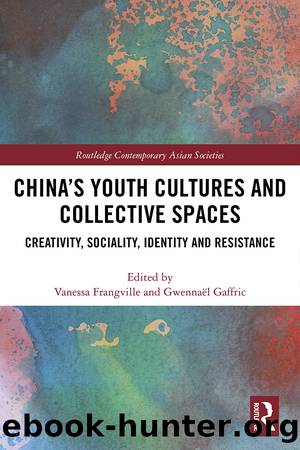China's Youth Cultures and Collective Spaces by Vanessa Frangville Gwennaël Gaffric

Author:Vanessa Frangville, Gwennaël Gaffric [Vanessa Frangville, Gwennaël Gaffric]
Language: eng
Format: epub
ISBN: 9780367173043
Barnesnoble:
Publisher: Taylor & Francis
Published: 2019-09-12T00:00:00+00:00
Circumventing censorship via creative strategies
As the worldâs largest Internet nation, China is unique in that its networks are denser, move faster, and change more rapidly than many of its Western counterparts. According to the data, âChina has been at the forefront of internet access for almost a decadeâ (Robson, 2017: para. 7). Chinese Internet users grew from 22.5 million in 2000 to over 720 million in 2016 while, for comparisonâs sake, the US grew from 121 million to 286 million in the same time frame. As of 2016, China had more Internet users than the next three largest countries combinedâthe US, India, and Japan (Internet Live Statistics, 2016). Of these, 313 million are monthly active users on Weibo and 700 million on Weixin. According to anthropologist Tom McDonald, âIt is easy for us to assume that âthe Chinese Internetâ ought to be a very drab and boring and constraining place, whereas actually, Chinese internet users are incredibly creative and the internet is incredibly livelyâ (quoted in Robson, 2017: para. 3). Citizens, merged with smartphones and social media platforms have new potentials to become decentered knots of world-making capable of powerful activist practices that spread and stoke dissent and information (DeLuca, Lawson, and Sun, 2012). Though Chinese censorship technology (largely produced by Western companies for surveillance purposes) thwarts open communication, it does not silence it. Social media platforms like Weibo and Weixin are wild enough to offer possibilities for surveillance by governments and activism via persistent imaginative methods simultaneously.
Many of Chinaâs youth, who grew up in a hyper-mediated environment, have learned to cope with the censorship-related barriers that sometimes thwart communication by deploying creativity as a means to circumvent obstacles and engage in important political conversations (Yang, 2009). These creative means include the use of code words, homonyms, memes, images, video, voice texts, and graphics, which grew in tandem with various technologies (Brunner and DeLuca, 2016; Link and Qiang, 2013; Mina, 2014). The proliferating, shifting, and changing online efforts in China supersede what Morozov (2012) terms slacktivism, which he defines as a form of faux-activism in which people like and share social media messages in a way that offers the appearance of participation but which has little impact other than making the user feel useful (even though s/he is not), thereby precluding more productive forms of activism. When the Occupy Wall Street (OWS) protests utilized Twitter and Facebook to organize and raise awareness in 2011, many critics deemed the online activity to be of little use despite the fact that online spaces are far more trafficked than physical protest sites such as Zuccotti Park in New York City. Scholars such as Morozov feared that if social movements adopted social media, this transition would lead to slacktivism and failed protests. However, as DeLuca, Lawson, and Sun (2012) write, âdespite the initial neglect and dismissive framing by traditional mass media organizationsâ the OWS protests, which utilized online organizing, live tweeting and broadcasting, and embodied protest âchanged the national conversationâ in that they compelled people to discuss income inequality and the economy in a different light (p.
Download
This site does not store any files on its server. We only index and link to content provided by other sites. Please contact the content providers to delete copyright contents if any and email us, we'll remove relevant links or contents immediately.
| Coloring Books for Grown-Ups | Humor |
| Movies | Performing Arts |
| Pop Culture | Puzzles & Games |
| Radio | Sheet Music & Scores |
| Television | Trivia & Fun Facts |
Paper Towns by Green John(5094)
Spare by Prince Harry The Duke of Sussex(5078)
Machine Learning at Scale with H2O by Gregory Keys | David Whiting(4200)
Never by Ken Follett(3801)
Learning C# by Developing Games with Unity 2021 by Harrison Ferrone(3335)
Fairy Tale by Stephen King(3229)
The Man Who Died Twice by Richard Osman(2998)
Fantastic Beasts and Where to Find Them: Illustrated edition by J.K. Rowling & Newt Scamander(2974)
Reminders of Him: A Novel by Colleen Hoover(2952)
Will by Will Smith(2797)
0041152001443424520 .pdf by Unknown(2787)
How The Mind Works by Steven Pinker(2735)
Fantastic Beasts and Where to Find Them: The Original Screenplay by J. K. Rowling(2470)
Never Lie: An addictive psychological thriller by Freida McFadden(2368)
Rationality by Steven Pinker(2295)
The God delusion by Richard Dawkins(2266)
Borders by unknow(2232)
It Starts With Us (It Ends with Us #2) by Colleen Hoover(2206)
Friends, Lovers, and the Big Terrible Thing by Matthew Perry(2126)
